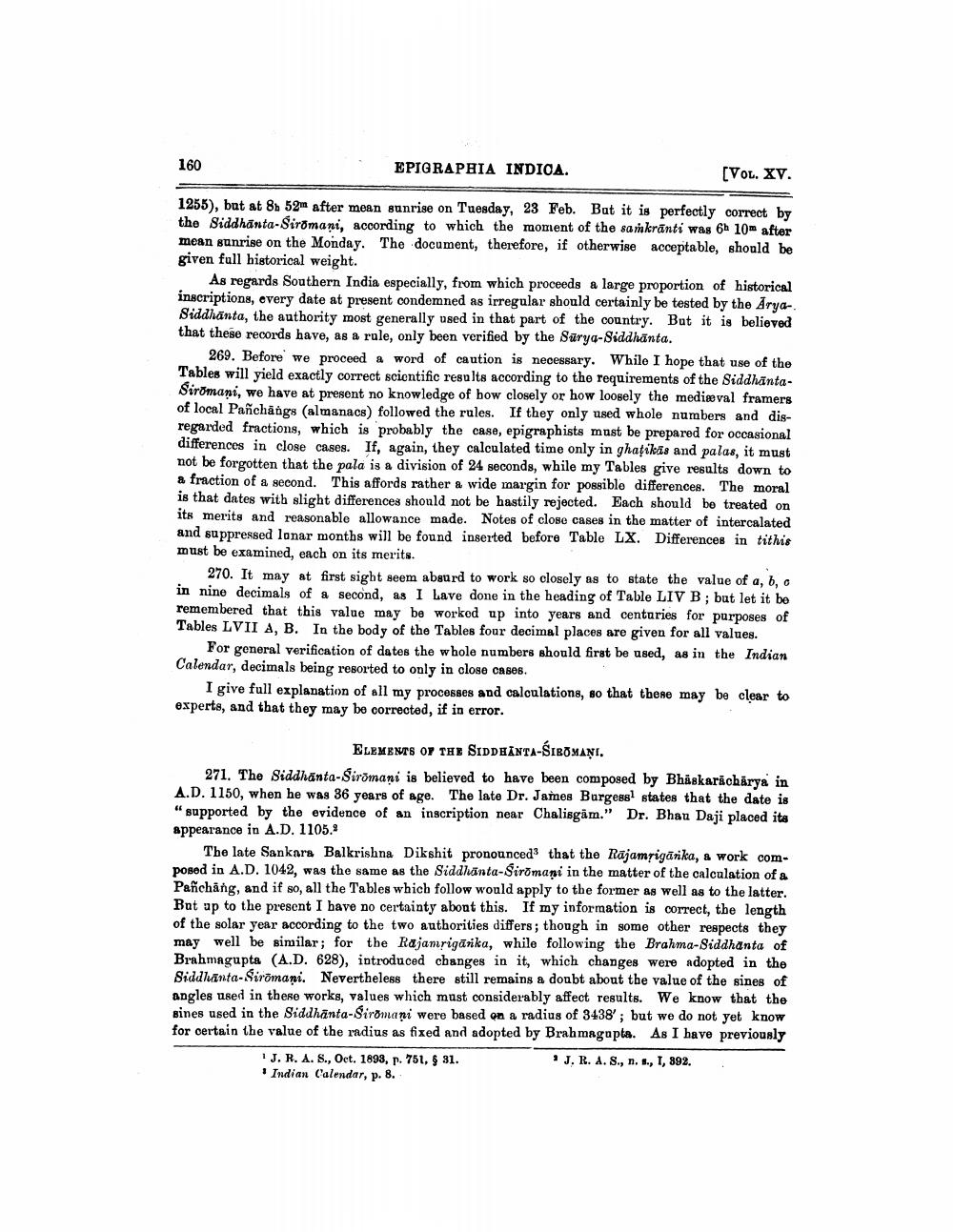________________
160
EPIGRAPHIA INDICA.
[VOL. XV.
1255), but at 8h 52m after mean sunrise on Tuesday, 23 Feb. But it is perfectly correct by the Siddhanta-Siromani, according to which the moment of the sankranti was 6h 10m after mean sunrise on the Monday. The document, therefore, if otherwise acceptable, should be given full historical weight.
As regards Southern India especially, from which proceeds a large proportion of historical inscriptions, every date at present condemned as irregular should certainly be tested by the AryaSiddhānta, the authority most generally used in that part of the country. But it is believed that these records have, as a rule, only been verified by the Surya-Siddhanta.
269. Before we proceed a word of caution is necessary. While I hope that use of the Tables will yield exactly correct scientific results according to the requirements of the SiddhāntaSiromani, we have at present no knowledge of how closely or how loosely the medieval framers of local Panchängs (almanacs) followed the rules. If they only used whole numbers and disregarded fractions, which is probably the case, epigraphists must be prepared for occasional differences in close cases. If, again, they calculated time only in ghatikis and palas, it must not be forgotten that the pala is a division of 24 seconds, while my Tables give results down to a fraction of a second. This affords rather a wide margin for possible differences. The moral is that dates with slight differences should not be hastily rejected. Each should be treated on its merits and reasonable allowance made. Notes of close cases in the matter of intercalated and suppressed lonar months will be found inserted before Table LX. Differences in tithis must be examined, each on its merits.
270. It may at first sight seem absurd to work so closely as to state the value of a, b, o in nine decimals of a second, as I have done in the heading of Table LIV B; but let it be remembered that this value may be worked up into years and centuries for purposes of Tables LVII A, B. In the body of the Tables four decimal places are given for all values.
For general verification of dates the whole numbers should first be used, as in the Indian Calendar, decimals being resorted to only in close cases.
I give full explanation of all my processes and calculations, so that there may be clear to experts, and that they may be corrected, if in error.
ELEMENTS OF THE SIDDHINTA-SIBOMAŅI. 271. The Siddhanta-Siromani is believed to have been composed by Bhaskaracharya in A.D. 1150, when he was 36 years of age. The late Dr. James Burgesel states that the date is "supported by the evidence of an inscription near Chalisgām." Dr. Bhau Daji placed its appearance in A.D. 1105.9
The late Sankara Balkrishna Dikshit pronounced that the Rājamrigātika, a work composed in A.D. 1042, was the same as the Siddhānta-Siromani in the matter of the calculation of a Pañching, and if so, all the Tables which follow would apply to the former as well as to the latter. But ap to the present I have no certainty about this. If my information is correct, the length of the solar year according to the two authorities differs; though in some other respects they may well be similar; for the Rajanrigārika, while following the Brahma-Siddhanta of Brahmagupts (A.D. 628), introduced changes in it, which changes were adopted in the Siddhānta- Siromani. Nevertheless there still remains a doubt about the value of the sines of angles used in these works, values which must considerably affect results. We know that the Bines used in the Siddhanta-Siromani were based on a radius of 3438'; but we do not yet know for certain the value of the radius as fixed and adopted by Brahmagapta. As I have previously "J. R. A. S., Oct. 1893, p. 751.9 31.
J. R. a. s., n. ., I, 892. Indian Calendar, p. 8.




